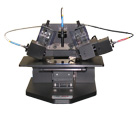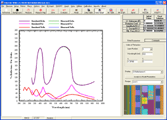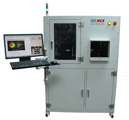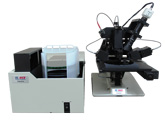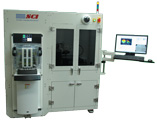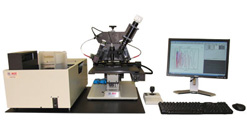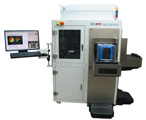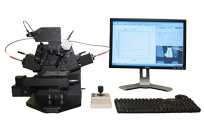The FilmTek� 2000SE is an affordable spectroscopic ellipsometer for
thin film characterization that
measures from the deep UV to NIR (190-1700nm). Based on a rotating
compensator design, the FilmTek� 2000SE spectroscopic ellipsometer
combines spectroscopic ellipsometry with multiple angle reflectometry
to make it ideally suited for measuring the thickness and optical
constants (n & k) of very thin films. The FilmTek� 3000SE spectroscopic
ellipsometer adds transmission measurement capability in addition to
spectroscopic ellipsometry and DUV reflectometry. The FilmTek� 2000SE
spectroscopic ellipsometer utilizes SCI's material modeling software to
provide an affordable and reliable thin film measurement tool for the simultaneous measurement
of film thickness, index of refraction, and extinction coefficient.
Virtually all translucent films ranging in thickness from 1 angstrom
to approximately 150 microns can be measured with high precision using
the FilmTek� 2000SE spectroscopic ellipsometer. Typical
FilmTek� 2000SE spectroscopic ellipsometer applications include:
 |
Semiconductor and dielectric
materials |
|
 |
Computer disks |
 |
Multilayer optical coatings |
|
 |
Coated glass |
 |
Optical antireflection coatings |
|
 |
Thin metals |
 |
Electro-optical materials |
|
 |
Solar cells |
Example Films
|
 |
SiOx |
|
 |
a-Si |
 |
SiNx |
|
 |
a-C:H |
 |
DLC |
|
 |
ITO |
 |
SOG |
|
 |
Polysilicon |
 |
Photoresist |
|
 |
Polyimide |
 |
Thin Metals |
|
 |
Low K Dielectric Films |
Example Substrates
|
 |
Silicon |
|
 |
GaAs |
 |
SOI |
|
 |
Glass |
 |
SOS |
|
 |
Aluminum |
FilmTek� 2000SE
Spectroscopic Ellipsometer Application Reports
FilmTek� spectroscopic ellipsometer metrology systems can measure a broad array of single and multi-layer
films including metallic, semiconductor, amorphous, crystalline, and dielectric
materials on virtually any substrate. FilmTek� can simultaneously determine:
Advanced Packaging and TSV Application Reports
MEMS Application Reports
R&D Application Reports
Optoelectronics Application Reports
Semiconductor Application Reports
Flat Panel Display Application Reports
Photovoltaic Application Reports
Spectroscopic
Ellipsometry Background
Ellipsometry is a versatile and powerful optical technique for the
investigation of the dielectric properties (complex refractive index or
dielectric function) of thin films. Ellipsometry has applications in
many different fields, from semiconductor physics to microelectronics
and biology, from basic research to industrial applications.
Ellipsometry is a very sensitive measurement technique and provides
unequalled capabilities for thin film measurement. Spectroscopic
Ellipsometry is non-destructive and contactless. Ellipsometry can yield
information about layers that are thinner than the wavelength of the
probing light itself, even down to a single atomic layer or less.
Ellipsometry can probe the complex refractive index or dielectric
function tensor, which gives access to fundamental physical parameters
and is related to a variety of sample properties, including morphology,
crystal quality, chemical composition, or electrical conductivity.
Ellipsometry is commonly used to characterize film thickness for single
layers or complex multilayer stacks ranging from a few angstroms or
tenths of a nanometer to several micrometers.
Ellipsometry measures the change of polarization upon reflection or
transmission. The name "ellipsometry" stems from the fact that the most
general state of polarization is elliptic. The ellipsometry technique
has been known for almost a century, and has many standard applications
today. Ellipsometry is also becoming more interesting to researchers in
other disciplines such as biology and medicine. Typically, ellipsometry
is performed in the reflection setup. The exact nature of the
polarization change in ellipsometry is determined by the sample's
properties (thickness, complex refractive index or dielectric function
tensor). Although optical techniques are inherently diffraction limited,
ellipsometry exploits phase information and the polarization state of
light, and can achieve angstrom resolution. Ellipsometry is applicable
to thin films with thickness less than a nanometer to several
micrometers. In ellipsometry the sample must be composed of a small
number of discrete, well-defined layers that are optically homogeneous
and isotropic. Violation of these assumptions will invalidate the
standard ellipsometric modeling procedure, and more advanced variants of
the ellipsometric technique must be applied.
In
ellipsometry, electromagnetic radiation is emitted by a light source and
linearly polarized by a polarizer. It can pass through a compensator
(retarder, quarter wave plate) and falls onto the sample. After
reflection the radiation passes a second polarizer, which is called
analyzer, and falls into the detector. Ellipsometry is a specular
optical technique (the angle of incidence equals the angle of
reflection). The incident and the reflected beam span the plane of
incidence. Standard ellipsometry measures two of the four Stokes
parameters, which are conventionally denoted by Ψ and Δ. The
polarization state of the light incident upon the sample may be
decomposed into an s and a p component (the s component is oscillating
perpendicular to the plane of incidence and parallel to the sample
surface, and the p component is oscillating parallel to the plane of
incidence). The amplitudes of the s and p components, after reflection
and normalized to their initial value, are denoted by rs and rp,
respectively. Ellipsometry measures the ratio of rs and rp. TanΨ is the
amplitude ratio upon reflection, and Δ is the phase shift (difference).
Since ellipsometry is measuring the ratio (or difference) of two values
(rather than the absolute value of either), ellipsometry is very robust,
accurate, and reproducible. For instance, ellipsometry is relatively
insensitive to scatter and fluctuations, and requires no standard sample
or reference beam.
Ellipsometry is an indirect method. That is, the measured Ψ and Δ
cannot be converted directly into the optical constants of the sample.
Normally, a model analysis must be performed with ellipsometry. Direct
inversion of Ψ and Δ is only possible in very simple cases of isotropic,
homogeneous and infinitely thick films. In all other ellipsometry cases
a layer model must be established, which considers the optical constants
(refractive index or dielectric function tensor) and thickness
parameters of all individual layers of the sample including the correct
layer sequence. Using an iterative procedure (least-squares
minimization) unknown optical constants and/or thickness parameters are
varied, and Ψ and Δ values are calculated using the Fresnel equations.
The calculated Ψ and Δ values, which match the experimental
ellipsometric data best, provide the optical constants and thickness
parameters of the sample.
Single wavelength ellipsometry uses a monochromatic light source. This
is usually a laser in the visible spectral region, for instance, a HeNe
laser with a wavelength of 632.8 nm. Therefore, single-wavelength
ellipsometry is also called laser ellipsometry. However, the
experimental output is restricted to one set of Ψ and Δ values per
measurement. Spectroscopic ellipsometry (SE) employs broad band light
sources, which cover a certain spectral range in the infrared, visible,
or ultraviolet spectral region. With spectroscopic ellipsometry the
complex refractive index or the dielectric function tensor in the
corresponding spectral region can be obtained, which gives access to a
large number of fundamental physical properties.
Standard vs.
Generalized Ellipsometry
Standard ellipsometry (or just 'ellipsometry') is applied when no
s-polarized light is converted into p-polarized light, nor vice versa.
This is the case for optically isotropic samples such as amorphous
materials or crystalline materials with a cubic crystal structure.
Standard ellipsometry is also sufficient for optically uniaxial samples
when the optical axis is aligned parallel to the surface normal. In all
other cases, when s-polarized light is converted into p-polarized light
and/or vice versa, the generalized ellipsometry approach must be
applied. Examples for generalized ellipsometry are arbitrarily aligned,
optically uniaxial samples, or optically biaxial samples.
Spectroscopic
Ellipsometry References
R.
M. A. Azzam and N. M. Bashara, Ellipsometry and Polarized Light,
Elsevier Science Pub Co (1987).
H.
G. Tompkins, A Users's Guide to Ellipsometry, Academic Press Inc,
London (1993).
H.
G. Tompkins and W. A. McGahan, Spectroscopic Ellipsometry and
Reflectometry, John Wiley & Sons Inc (1999).
H.
G. Tompkins and E. A. Irene (Editors), Handbook of Ellipsometry,
William Andrews Publications, Norwich, NY (2005).
Copyright� Scientific Computing International 1993-2019.
All rights reserved.
